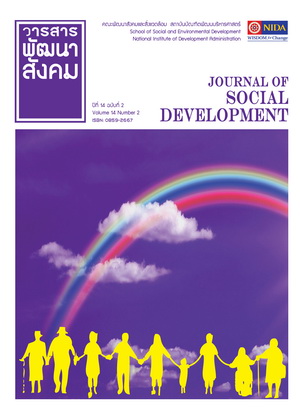ปัจจัยบ่งชี้ความแตกต่างการทุพพลภาพของผู้สูงอายุหญิงและชายไทย
Main Article Content
Abstract
การทุพพลภาพในวัยสูงอายุเป็นปัญหาสำคัญ เชิงสุขภาพของไทย ที่มีสภาพปัญหาในเพศหญิงและชายต่างกัน การศึกษานี้จึงมีวัตถุประสงค์ เพื่อเปรียบเทียบความชุกทุพพลภาพและผลของปัจจัยเสี่ยงต่อการทุพพลภาพระหว่าง ผู้สูงอายุเพศหญิงและชาย ข้อมูลรายงานการสำรวจผู้สูงอายุปี 2550 สำนักงานสถิติแห่งชาติ (ตัวอย่าง 30,427 คน) ถูกนำมาวิเคราะห์ความชุกทุพพลภาพจากการทำกิจกรรมประจำวัน ตามเพศและแนวโน้มตามอายุ และวิเคราะห์ความสัมพันธ์ระหว่างเพศกับปัจจัยอิสระที่มีปฏิสัมพันธ์กับตัว แปรหุ่นการทุพพลภาพ โดยใช้สมการถดถอยโลจิสติกแบบหลายตัวแปรและศึกษากลุ่มย่อยตามกลุ่มอายุ ผลการศึกษา พบว่า เพศหญิงมีความชุกทุพพลภาพในวัยสูงอายุสูงกว่าชายทั้งกลุ่มกิจกรรมพื้นฐานและ กิจกรรมทางกาย แต่ช่วงตั้งแต่เข้าวัยสูงอายุจนถึงเริ่มต้นวัยปลาย ความชุกทุพพลภาพกิจกรรมพื้นฐานของชายกลับสูงกว่าหญิงเล็กน้อย เพศหญิงมีความสัมพันธ์กับปัจจัยเสี่ยงทางสุขภาพและสังคมมากกว่าชาย ยกเว้น การเตรียมพร้อมสุขภาพกายและจิตใจ โดยภาวะสุขภาพและปัจจัยสังคมบางประการมีผลต่อการทุพพลภาพในวัยสูงอายุในเพศ หญิงมากกว่าชาย ได้แก่ โรคหัวใจ การไม่สามารถเข้าถึงโรงพยาบาลรัฐ ระดับการศึกษาน้อย เครือข่ายเกื้อหนุนในครอบครัวน้อย และ การไม่อยู่ในพื้นที่เมืองหลวงและปริมณฑล ส่วนปัจจัยที่มีผลในเพศชายมากกว่าหญิง ได้แก่ โรคมะเร็ง เบาหวาน สถานภาพโสด การเตรียมพร้อมที่ไม่ดีทางกายและการเงิน และความมั่งคั่งน้อย และปัจจัยบ่งชี้ความแตกต่างทางเพศบางประการยังขึ้นกับช่วงอายุ ได้แก่ โรคหลอดเลือดสมอง และ ความดันโลหิตสูง สรุปโดยรวมเพศหญิงพบทุพพลภาพจากกิจกรรมประจำวันในวัยสูงอายุมากกว่าชายโดย เฉพาะในกลุ่มอายุมาก แต่ทุพพลภาพที่รุนแรงจากกิจกรรมพื้นฐานยังพบในเพศชายได้มากกว่าโดยเฉพาะใน ช่วงการสูงอายุวัยต้น ปัจจัยบ่งชี้การมีทุพพลภาพของเพศหญิงที่สูงกว่า ได้แก่ โรคเรื้อรัง การศึกษา ครอบครัวและสภาพแวดล้อมทางสังคม ส่วนปัจจัยบ่งชี้การมีทุพพลภาพจากกิจกรรมพื้นฐานของเพศชายที่สูงกว่า ได้แก่ โรคเรื้อรัง และสถานะทางเศรษฐกิจ
คำสำคัญ: เพศ ความแตกต่าง ทุพพลภาพ ประเทศไทย ผู้สูงอายุ
Abstract
In Thailand, disability in old age is the important health problem which manifests itself differently in gender dimension. Thus, the objectives were to compare the prevalence of disability and the effects of risk factors on disability between female and male elderly. The 2007 elderly survey data reported by NSO (30,427 sample units) was analyzed through age-sex specific prevalence and multiple logistic regression with interacting dummy variable of disablement condition across various kinds of activity of daily living (ADL) and subgroup study by age group. The results found that the prevalence of old age disability in women (each kind of ADL) was all higher than one in men; however, prevalence of severe disabilities (Basic ADL; BADL) was higher in men until the early period of the oldest old. Except mental and physical preparation, the older women related to health and social risks more than the older men did. Some of health conditions and social factors such as having heart disease, not accessible to public hospital, low academic level, poor family support network, and not living in capital with metropolitan area affected on disability in old age among women more than men. On the contrary, having cancer and diabetes, single status, not well-prepared behaviors (physical and financial), and low wealth affected on disability in old age among men more than women. However, the effect of stroke and hypertension depended on aging period. The conclusion is that the ADL disability in old age has been common among women; however, severe disability (BADL) is more common among men especially in the period of the young old. Factors indicate the higher prevalence of disability among women were chronic diseases, education, family support, and social environments. Factors indicate the higher prevalence of BADL disability among men were chronic diseases and economic status.
Key words: gender, differences, disability, Thailand, elderly

